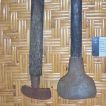Not many people know that Bali has a part (district) at south-east side consisting three islands. The biggest one is named Nusa Penida. The smaller island is called Nusa Lembongan and the smallest one is known as Nusa Ceningan, this island is situated between Nusa penida and Nusa Lembongan. Each of them has own tourist destination and unique art. However, Nusa Penida offers awesome beaches that are still pure and conservation for birds, plants, and turtle, and a very special dance, because of that people often call it as Golden Egg but it has not hatched yet. Why?
Nusa Penida is a district belonging to Klungkung regency. In order to get to Nusa Penida you have to take a trip to Padang Bay first. Then, you have to cross Badung Strait (between Bali Island and Nusa Penida) using “Roro-Nusa Jaya Abadi” the only ferryboat that can help you cross to Nusa Penida. After spending about one hour voyage then you will reach Toya Pakeh Harbor. At there you can travel the island by “omprengan” or modified pick-up car.

Nusa Penida has many tourism destinations that can be enjoyed. Beaches are very easy to be found in this island, Puncak Temu where you can find beautiful scene, several choices of art performance can be watched.
A beach which is closest to the harbor is situated in Toya Pakeh village. In this beach, there is a floating restaurant. The most important thing is you are allowed to dive in this beach and see very beautiful reef. Indeed, in this beach, reef is an important component that is still preserved from any damage.
Besides Toya Pakeh Beach, Nusa Penida has a very cozy beach. It is around 4 km from Toya Pakeh. This beach is situated in Sakti Village at Banjar Penida. I guarantee you that this beach is different from the famous Kuta or Sanur. The beach which people call it Crystal Bay, is very quiet, far from crowd. The water is sparkling blue. The sand is black but it is covered by white sand. The beach is very clean because people at Banjar Penida keep it clean. And the beach is gated by escarpment.
Far from the beach, situated on the top of elevated ground is Puncak Temu, from this place you can get bird-eye view of beautiful scenes of Nusa Penida. There are also some white shrines can be found in this place. Around the srines, there are many trees seems keep it from outside world. Different from other places at Nusa Penida which tend to be dry and lack of water, Puncak Temu is dominated with lush green vegetables signing that water is available there.
On very south of Nusa Penida there are villages named Sekartaji and Suana. In these villages, Nusa Penida Endemic Bird: little sulfur-crested cockatoo can be found. In all regions in Nusa Penida there is only four little sulfur-crested cockatoo left. One female and others are male. You are lucky if you can take a photograph of this bird since this bird is very energetic.
Nusa Penida does not only offer the amazing tourism destination but also unique dances. Sanghyang Dewa dance is one of them. This dance must be danced by little girl who has not got menstruation yet. People of Nusa Penida categorize it into sacred dance because it is danced on special day at the temple. That little girl is unconscious while she dances it.
Nusa Penida does not only offer the amazing tourism destination but also unique dances. Sanghyang Dewa dance is one of them. This dance must be danced by little girl who has not got menstruation yet. People of Nusa Penida categorize it into sacred dance because it is danced on special day at the temple. That little girl is unconscious while she dances it.
The explanation above is only a few from various arts and tourism destinations in Nusa Penida. However, not many tourists have information about this island and only few tourists visit this island. Nusa Penida is a potential tourist destination but it has not managed yet. No wonder this Golden Egg has not hatched yet.
source:blog.baliwww.com



























































